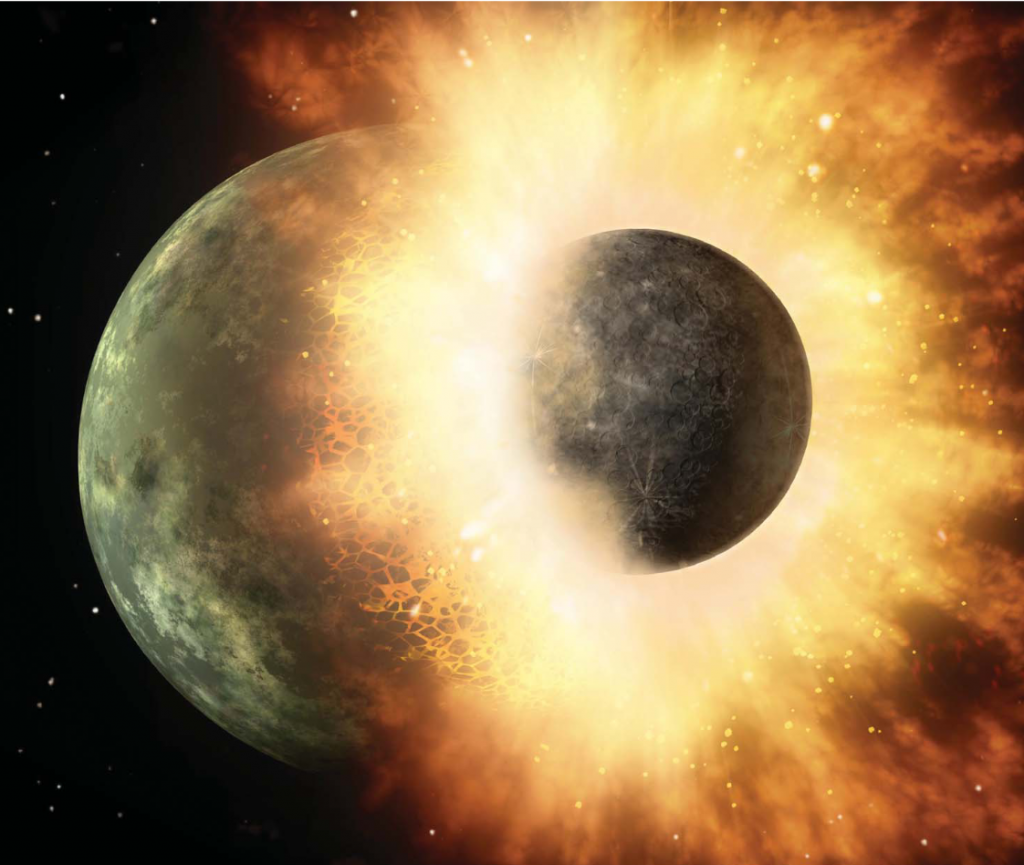
Planetary Research
Image courtesy of NASA
Our Pulsed Power scientists are answering intriguing questions like these:
- What are the various planets made of?
- Why is Saturn more luminous than Jupiter?
- What causes Neptune’s abnormal magnetic field?
- Does it rain diamonds deep in Neptune’s atmosphere?
Supercomputers and quantum mechanics are also used to calculate and simulate atoms, molecules, solids, and plasmas under planetary conditions. By combining experiments and theory, we are gaining new revolutionary insights into the structure and dynamics of planets.
New Insights into Planetary Accretion Processes
The Earth was formed by repeated collision and subsequent combination of small planetesimals into ever larger bodies in a process called accretion. To better understand accretionary processes we have, together with collaborators from Lawrence Livermore National Laboratory, the University of California Davis, and Harvard University, combined shock compression experiments on Sandia’s Z Machine with quantum mechanical simulations of magnesium silicate – a common planetary building block.
The combined experiments and calculations conducted by Seth Root, Joshua Townsend, and Luke Shulenberger, were recently published in the journal, Geophysical Research Letters. This information provides planetary scientists with the most accurate thermodynamic model of magnesium silicate under high pressure and temperature. The results provide new constraints which inform models of planetary formation and may help us better understand how our planet and others are formed.
Metallic Water in Giant Planets

Supercomputer simulations by two Sandia researchers have significantly altered the theoretical diagram universally used by scientists to understand the characteristics of water at extreme temperatures and pressures.
The new computational model also expands the known range of water’s electrical conductivity.
The Sandia theoretical study by Thomas Mattsson and Michael Desjarlais showed that phase boundaries for “metallic water” — water with its electrons able to migrate like a metal’s — should be lowered from 7,000 to 4,000 kelvin and from 250 to 100 gigapascals (GPa).
The lowered boundary is sure to revise astronomers’ calculations of the strength of the magnetic cores of gas-giant planets like Neptune. Because the planet’s temperatures and pressures lie partly in the revised sector, its electrically conducting water probably contributes to its magnetic field, formerly thought to be generated only by the planet’s core. Learn more: ‘Metallic Water’ Alters Characteristics of Neptune, Impacts Other Physics.
Neptune’s Abnormal Magnetic Field
While Earth, Jupiter, and Saturn all have normal magnetic fields with a magnetic north and south pole, Neptune and Uranus have abnormal magnetic fields with complex, multipolar character. Since magnetic fields are generated by the motion of conducting fluids inside the planet, substantial differences in their interior structure and composition must exist. Learn more: The phase diagram of water and the magnetic fields of Uranus and Neptune.
The reason for this difference was unknown until a few years ago, when Sabine Stanley and Jeremy Bloxham of Harvard University discovered that if a planet has layers of different properties, anomalous magnetic fields are possible. In collaboration with Sandia and the University of Rostock in Germany, scientists provided an explanation for the layering/stratification and the intriguing changes that water undergoes in these conditions.
The idea of compressing water is foreign to our daily experience. Nevertheless, an accurate estimate of water’s shrinking volume under the huge gravitational pressures of large planets is essential to astrophysicists trying to model the evolution of the universe. They need to assume how much space is taken up by water trapped under high energy density and pressure, deep inside a planet, to calculate how much is needed of other elements to flesh out the planet’s astronomical image.
“Our results question science’s understanding of the internal structure of these planets and should require revisiting essentially all the modeling of ice giants within and outside our solar system.”
-Marcus Knudson, Sandia National Labs
Untangling the long-standing mystery:
Why is iron splattered throughout the Earth’s Mantle? Sandia’s Z Machine provides hard data on the surprisingly low amount of pressure required to metamorphose iron from a massive intrusive force to a gentle vaporized mist as astrophysical bodies collided in space during the later stage of Earth’s formation. Read more in this article from the Sandia Lab News.
In another article, Sandia scientist’s determine the entropy in the shock state of iron using a recently developed shock-and-release experimental technique implemented on the Z-Machine. We find that the shock pressure required to vaporize iron is lower than the previous theoretical estimate and readily achieved by the high velocity impacts at the end stages of accretion. We suggest that impact vaporization of planetismal cores dispersed iron over the surface of the growing Earth and enhanced chemical equilibration with the mantle. Read more…